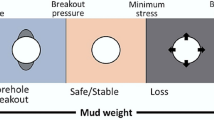Abstract
Borehole wall collapse is rare in the drilling of carbonate rock formations. However, several wells in the Maantang–Leikoupo carbonate formation have collapsed and released blocks to varying degrees, which have caused sticking and hindered efficient development of oil and gas resources. Thus, through the study of macroscopic and microscopic characteristics of carbonate rocks in this area, it is concluded that the fractures in this area are developed. In order to facilitate the analysis of formation fracture development, the concept of formation integrity coefficient which is commonly used in rock engineering was introduced. Firstly, the feasibility of using the formation integrity coefficient to characterize the degree of rock fragmentation was verified by the laboratory acoustic experiment. Finally, the empirical formulas were proposed regarding the formation integrity coefficient and the cohesion of carbonate rocks in this area by combining the laboratory mechanical experiment and acoustic experiment, and a calculation model for the collapse density considering formation integrity was established. Results provide guidance for research on carbonate wellbore stability, especially for fractured carbonate strata.

















Similar content being viewed by others
References
Chen P (2011) Drilling and completion engineering. Petroleum industry press, Beijing
Deng J (1998) Mechanical mechanism of wellbore wall instability in drilling engineering. Petroleum industry press, Beijing
Ezati M, Azizzadeh M, Riahi MA, Fattahpour V, Honarmand J (2020) Wellbore stability analysis using integrated geomechanical modeling: a case study from the Sarvak reservoir in one of the SW Iranian oil fields. Arabian J Geosci 13(4):149–167
Fan X (2010) Oil and gas drilling geology. Chongqing university press, Chongqing
Jin Y, Chen M (2012) Wellbore wall stability mechanics. Science press, Beijing
Labenski F, Reid P, Santos H (2003) Drilling fluids approaches for control of wellbore instability in fractured formations. Society of Petroleum Engineers, Abu Dhabi, United Arab Emirates
Li Q, Heliot D, Zhao L et al (2000) Abnormal pressure detection and wellbore stability evaluation in carbonate formations of East Sichuan, China. Society of Petroleum Engineers, New Orleans
Li Y, Wang C, Xu L (2012) Prediction method of fractured formation pressure based on BP neural network. Western Prospecting Project 24(10):101–102
Lin Y, Yan Z (2006) Application of the Kv method to the judgement of rock mass integrality. South China J Seismol 26(2):80–83
Liu H, Liu T, Meng Y et al (2019) Experimental study and evaluation for borehole stability of fractured limestone formation. J Petroleum Sci Eng 180:130–137
Liu Z, Chen M, Jin Y et al (2013) Analysis on wellbore stability of open hole in fractured formation. Oil Drilling Product Technol 35(2):39–43
Peng G, Zhang L, Pan Z (2018) Discussion on rock mass integrity and surrounding rock classification of tunnels. Guangdong Architecture Civil Eng 25(10):1–5 +37
Qu D (2000) Study on the cause and anti-collapse measures of high and steep structural well collapse in east Si Chuan. Drilling Product Technol 23(05):85–86
Wang G, Zhang (1990) Analysis of fracturing pressure measurements derived from full waveform acoustic logs in carbonates. Geophysical Well Logging 14(03):178–188
Yao R, He S, Long P et al (2012) A mathematical model of calculating collapse pressure for fracture formation. Drilling Product Technol 35(1):21–23
Yu D, Wang B (2014) Study on the model of wellbore stability of horizontal well drilling in naturally fractured reservoirs. Sino-Global Energy 19(5):51–54
Zeng W, Liu X, Liang L, Xiong J (2018) Analysis of influencing factors of wellbore stability in shale formations. Arabian J Geosci 11(18):532–541
Zhang F, Zhang S, Jiang X, Lu R, Chen M (2008) Borehole stability in naturally fractured reservoirs during production tests. Petroleum Sci 5(3):247–250
Zhao X, Hu X, Xiao K et al (2018) Characteristics and major control factors of natural fractures in carbonate reservoirs of Leikoupo Formation in Pengzhou area, western Sichuan Basin. Oil Gas Geol 39(01):30–39
Author information
Authors and Affiliations
Corresponding authors
Ethics declarations
Conflict of interest
The authors declare no competing interests.
Additional information
Responsible Editor: Santanu Banerjee
Highlights
• The concept of formation integrity coefficient is introduced to reflect the degree of carbonate formation fragmentation.
• Through a series of laboratory experiments, the formation strength was studied, and the empirical formulas of formation integrity coefficient and carbonate cohesion were fitted with the experimental data.
• Combined with the empirical formula of formation integrity coefficient and carbonate cohesion obtained above, the calculation formula of collapse density considering the degree of formation fragmentation is obtained.
Rights and permissions
About this article
Cite this article
Liu, H., Cui, S., Meng, Y. et al. A new method for wellbore stability evaluation based on fractured carbonate reservoir rock breaking degree. Arab J Geosci 14, 647 (2021). https://doi.org/10.1007/s12517-021-06941-7
Received:
Accepted:
Published:
DOI: https://doi.org/10.1007/s12517-021-06941-7




